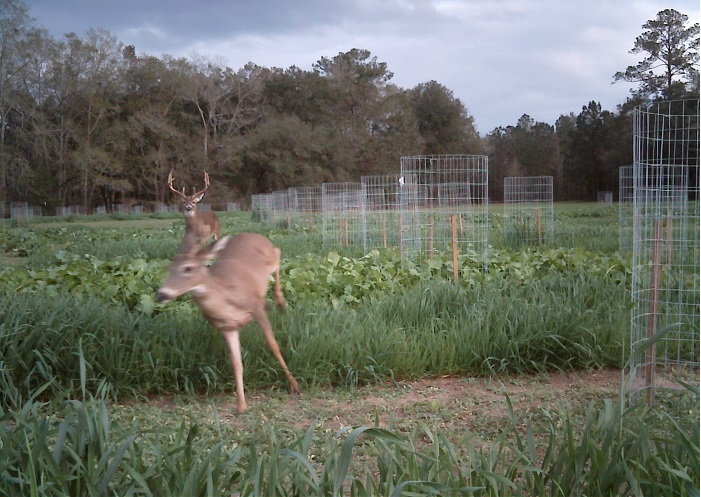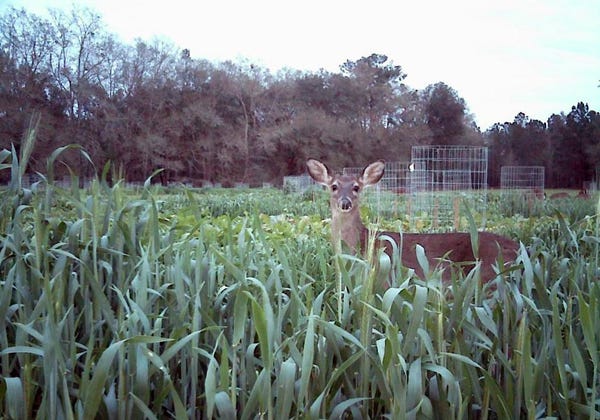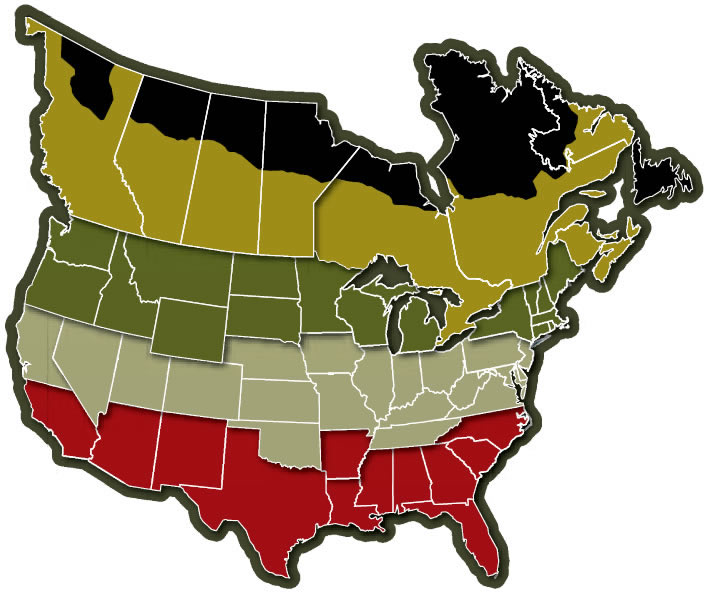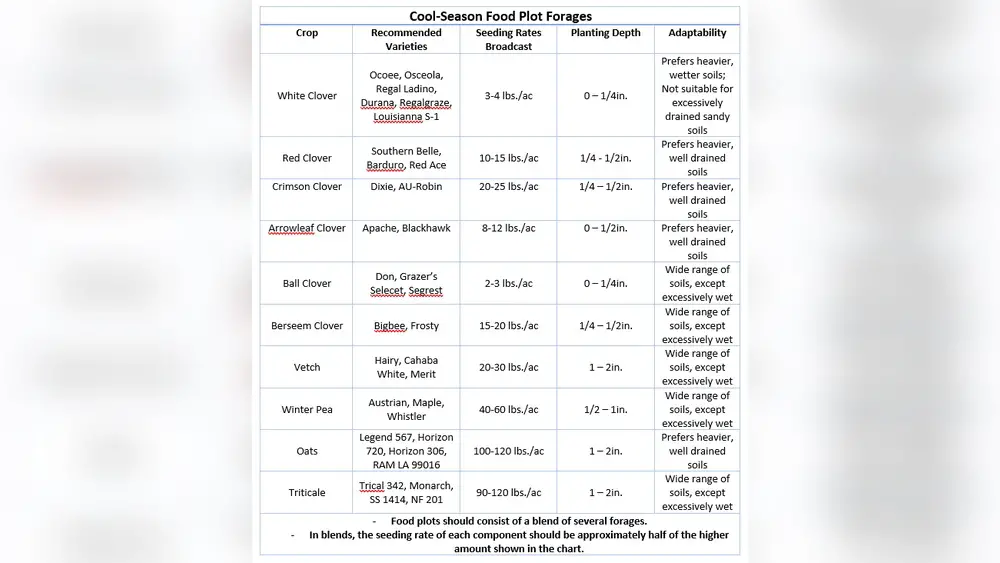If you’re looking to grow successful food plots in Florida, timing is everything. Planting at the right time can make the difference between a thriving plot that attracts deer and one that struggles to take root.
You want your food plots to be lush and ready when deer are most active, especially if you’re preparing for the fall hunting season. But with Florida’s unique climate, knowing exactly when to plant can be confusing. You’ll discover the best months to plant both warm-season and cool-season crops, so your food plots reach their peak just when you need them.
Keep reading to learn how to get the most from your planting efforts and make your food plots a magnet for wildlife all year long.

Credit: nwdistrict.ifas.ufl.edu
Florida Climate And Food Plots
Florida’s climate plays a key role in growing successful food plots. The state has warm temperatures most of the year. Rainfall varies by season and region. These conditions impact the choice and timing of crops planted for deer and wildlife. Understanding Florida’s climate helps choose the best planting times. It also guides how to prepare the soil for healthy growth.
Seasonal Weather Patterns
Florida has two main seasons: wet and dry. The wet season runs from June to September. Expect heavy rains and high humidity during these months. The dry season lasts from October to May. It brings cooler temperatures and less rain. Planting in late summer or early fall fits the dry season. This timing helps crops like oats and brassicas grow well. Spring plantings from February to May also work well. This matches the warming temperatures and moderate rainfall. Avoid planting during the peak wet season. Too much water can harm young plants and delay growth.
Soil Types And Preparation
Florida soil varies greatly across the state. Common types include sandy, clay, and loamy soils. Sandy soils drain water quickly but hold fewer nutrients. Clay soils retain moisture but may cause drainage problems. Loamy soils offer a good balance of drainage and nutrients. Testing soil before planting is vital. It reveals pH levels and nutrient needs. Adding lime adjusts soil acidity. Fertilizers supply needed nutrients for strong plants. Clearing weeds and loosening soil improves root growth. Proper soil preparation sets the stage for a healthy food plot.
Optimal Planting Seasons
Planting food plots in Florida requires timing to match the climate and wildlife needs. Choosing the right season helps crops grow strong and attract deer effectively. Florida’s mild winters and hot summers create unique planting windows. Understanding these periods improves your food plot success.
Each season offers distinct benefits. Spring, fall, and late summer each serve as good planting times. Selecting the right crops for each window is key. Below are details on the best planting seasons for Florida food plots.
Spring Planting Window
Spring planting runs from February through May in Florida. This period offers warming soil and longer daylight. Many warm-season crops like corn and soybeans thrive in spring. Planting early allows crops to mature before the summer heat arrives. Spring plots provide fresh food for wildlife after winter.
Fall Planting Window
Fall planting happens between July and September. This window suits cool-season crops such as oats, rye, and brassicas. These plants grow well in Florida’s mild fall weather. Fall plots often reach peak growth during deer’s peak activity. This makes fall planting ideal for hunting season preparation.
Late Summer Opportunities
Late summer, from late July to early August, offers a smaller planting chance. This period is useful for quick-growing crops. It helps fill gaps between summer and fall plantings. Late summer plots can support deer during hot months. Timely watering and care boost success in this window.
Cool-season Crops For Florida
Cool-season crops thrive in Florida’s milder fall and winter months. These plants grow well when temperatures drop but do not freeze. Planting cool-season crops in late summer or early fall ensures they mature when deer are most active. These crops provide nutritious food and cover for wildlife during cooler months. Understanding which crops to plant helps create effective food plots that attract deer and other game.
Brassicas Varieties
Brassicas are popular cool-season plants for Florida food plots. They include turnips, radishes, and kale. These crops grow quickly and offer high nutrition. Deer love their leaves and roots, especially during winter. Brassicas handle Florida’s mild cold well without damage. Plant them in late August to early September for best results. They boost deer health and attract more animals to your plot.
Oats And Winter Rye
Oats and winter rye are excellent grains for food plots. They germinate fast and tolerate cooler temperatures. Oats provide soft, leafy forage that deer enjoy. Winter rye grows tall and dense, offering both food and shelter. Plant these grains in late summer to early fall. They stay green longer and keep deer feeding into winter. These grains improve soil quality and prevent erosion too.
Benefits For Deer Attractiveness
Cool-season crops increase deer activity on your land. Their nutrients help deer build fat for winter survival. These plants fill gaps when natural food is scarce. Deer find these crops tasty and easy to digest. Food plots with cool-season crops attract more deer and keep them nearby. This improves hunting opportunities and wildlife observation. Healthy plots support a strong deer population year-round.

Credit: www.farmprogress.com
Warm-season Crop Choices
Choosing the right warm-season crops for food plots in Florida makes a big difference. Warm-season crops thrive in Florida’s hot and humid climate. They grow best from late spring through summer. These crops provide good nutrition and cover for deer during the warmer months. Selecting suitable plants helps maintain healthy deer populations year-round.
Perennials And Annuals
Perennials come back year after year with little effort. Examples include clover and chicory. They establish deep roots and handle Florida’s summer heat well. Annuals need to be planted each season but grow quickly. Common annuals are cowpeas and soybeans. Mixing perennials and annuals ensures food plots stay green and productive longer.
Summer Planting Tips
Plant warm-season crops after the last frost date, usually in late April or May. Use well-prepared soil with good drainage. Water regularly during dry spells to keep plants healthy. Avoid planting too late in summer to prevent crops from maturing during cool weather. Timing is key to getting the best growth and nutrition from your plots.
Supporting Deer Nutrition
Warm-season crops provide essential nutrients for deer in Florida’s summer months. High-protein plants like clover support growth and antler development. Legumes add nitrogen to the soil, improving plant health. Diverse food plots offer a balanced diet and attract deer consistently. Proper nutrition helps deer stay healthy and active throughout the year.
Planting Techniques
Planting food plots in Florida requires careful techniques to ensure healthy growth and high yields. Proper planting methods help seeds grow strong and attract wildlife. Following simple steps boosts your success and makes your food plot thrive.
Site Selection And Soil Testing
Choose a spot with good sunlight and drainage. Avoid areas that stay wet or shaded all day. Test the soil to check its pH and nutrient levels. Soil testing helps you know what fertilizers your plot needs. This step improves seed growth and plant health.
Seedbed Preparation
Clear the area of weeds, rocks, and debris before planting. Loosen the soil by tilling or plowing to create a soft bed. A fine seedbed lets seeds settle and sprout easily. Proper preparation also improves water absorption and root growth.
Planting Depth And Spacing
Plant seeds at the depth recommended on the seed package. Too deep, and seeds may not sprout well. Too shallow, and they risk drying out or being eaten. Space seeds evenly to avoid overcrowding. Good spacing allows air and sunlight to reach each plant.
Watering And Maintenance
Proper watering and maintenance are essential for a healthy food plot in Florida. Consistent care helps crops grow strong and attracts more wildlife. Understanding how to water, control weeds and pests, and fertilize keeps your food plot productive throughout the season.
Irrigation Strategies
Florida’s climate can be dry during certain months. Use drip irrigation or soaker hoses for efficient watering. Water early in the morning to reduce evaporation. Avoid overwatering to prevent root diseases. Monitor soil moisture regularly to adjust watering schedules.
Weed And Pest Control
Weeds compete with your crops for nutrients and water. Remove weeds by hand or use herbicides safe for your plants. Check food plots weekly for signs of pests. Use natural predators or organic pesticides to control harmful insects. Keep the area clean to reduce pest habitats.
Fertilization Schedules
Fertilize food plots based on soil test results. Apply fertilizer before planting for best results. Use nitrogen-rich fertilizers for leafy crops. Repeat applications every 4 to 6 weeks during the growing season. Avoid over-fertilizing to protect the environment and plants.
Timing For Hunting Success
Timing plays a crucial role in hunting success in Florida. Properly timed food plots can attract deer during key movement periods. Planting at the right moment ensures crops mature as deer activity peaks. This section explores how timing affects deer movement, population control, and food plot effectiveness.
Aligning Maturity With Deer Movement
Plant food plots so crops reach peak growth during peak deer activity. In Florida, cool-season crops like brassicas and oats should be planted in late summer or early fall. This timing matches deer feeding habits before and during the hunting season. Mature plots hold deer longer and improve hunting opportunities.
Managing Doe Populations
Food plot timing helps control the doe population by providing nutrition at critical times. Late summer planting supports does as they prepare for winter fawns. Healthy does produce stronger offspring, improving overall herd quality. Well-timed plots reduce pressure on natural food sources and encourage balanced populations.
Maximizing Food Plot Impact
Planting at the right time maximizes crop yield and attractiveness to deer. Early fall plantings allow plants to establish before colder weather arrives. This creates a reliable food source that draws deer consistently. Proper timing also reduces weed competition and soil stress, leading to better plots.

Credit: www.whitetailinstituteservices.com
Regional Variations Within Florida
Florida’s diverse climate zones create unique challenges and opportunities for planting food plots. Understanding regional variations helps growers choose the right planting time. Each part of Florida has its own temperature range, rainfall patterns, and soil types. These factors influence crop growth and timing. Paying attention to local conditions improves food plot success and wildlife attraction.
North Vs. South Florida Differences
North Florida experiences cooler winters and a shorter growing season. Plant cool-season crops like oats and rye in late summer or early fall. Spring planting happens from February to April. South Florida has milder winters and a longer growing season. This region supports warm-season crops year-round. Plant peas and corn from March to June. Adjust planting schedules to match local weather patterns.
Panhandle Planting Tips
The Florida Panhandle has a more temperate climate with colder winters. Plant cool-season crops earlier than in central Florida. Late August or early September works well for fall plantings. Use soil testing to select proper fertilizers. This region benefits from crop diversity to handle weather swings. Monitor rainfall closely to avoid planting during heavy rains.
Adjusting For Microclimates
Microclimates exist within small areas and affect planting success. Shade, elevation, and nearby water bodies change temperature and moisture. Observe your plot’s conditions before planting. Planting on a south-facing slope warms soil faster. Avoid low spots that collect cold air or water. Adjust planting dates and crop choices to suit these subtle differences. This attention improves growth and food plot quality.
Common Challenges And Solutions
Planting food plots in Florida presents unique challenges. The state’s climate can affect seed germination and crop growth. Understanding these challenges helps improve food plot success. Below are common problems and practical solutions.
Late Planting Risks
Planting food plots late can reduce crop yield. Seeds may not fully mature before cold weather arrives. This leads to poor forage quality and less deer attraction. To avoid this, start planting early in recommended months. Use fast-growing crop varieties to maximize growth time. Monitor weather forecasts and adjust planting dates accordingly.
Dealing With Drought Conditions
Drought is a frequent problem in Florida’s dry season. Lack of water stresses plants and lowers growth. To manage drought, install drip irrigation or soaker hoses. Mulching helps retain soil moisture and reduces evaporation. Choose drought-tolerant plant species to survive dry spells. Water food plots deeply but infrequently to encourage strong roots.
Preventing Soil Erosion
Heavy rains can cause soil erosion in food plots. Eroded soil loses nutrients needed for healthy plants. Plant cover crops or grasses around plots to hold soil in place. Use contour planting or terraces on slopes to slow water flow. Adding organic mulch improves soil structure and reduces runoff. Check plots after storms and repair any erosion damage quickly.
Recommended Seed Mixes
Choosing the right seed mixes is key for a successful food plot in Florida. Seeds must suit the soil type and attract local wildlife. Using the proper mix helps plants grow strong and healthy. This supports deer and other animals all season. Below are the top seed options for different needs and soils.
Best Seeds For Sandy Soils
Sandy soils drain quickly and hold less nutrients. Seeds that tolerate dryness and poor soil work best here. Clovers like crimson and arrowleaf do well. Annual ryegrass and oats also grow strong in sandy soil. These seeds help improve soil health and provide good cover. They also attract deer with tasty, nutritious forage.
Blends For High Deer Attraction
Deer prefer plants rich in protein and easy to digest. Brassicas, such as turnips and radishes, are top choices. These plants provide food late in the season. Combining brassicas with clover and chicory creates a balanced blend. This mix offers food throughout the year. It keeps deer returning to your plot regularly.
Sources And Suppliers
Buy seeds from local suppliers familiar with Florida’s climate. They offer blends designed for regional success. Check garden centers and farm stores for seed options. Online retailers also provide many seed mixes tailored to food plots. Always choose high-quality seeds with good germination rates. This ensures your plot grows thick and healthy.
Frequently Asked Questions
When To Plant Food Plots For Deer In Florida?
Plant deer food plots in Florida during late summer to early fall, typically from July to September. This timing supports cool-season crops like brassicas and winter rye, ensuring peak growth for the fall hunting season and attracting deer effectively.
What Month Should You Plant Food Plots?
Plant food plots in spring (February to May) for warm-season crops and late summer to early fall (July to September) for cool-season crops. This timing ensures optimal growth and attractiveness for wildlife during hunting seasons.
How Many Deer Will A 2 Acre Food Plot Feed?
A 2-acre food plot can feed about 8 to 10 deer, depending on plot quality and deer size.
Is September Too Late To Plant A Food Plot?
September is not too late to plant a food plot. Plant cool-season crops like brassicas, oats, and rye for fall growth. This timing ensures healthy, attractive plots during peak deer activity. Adequate soil moisture improves seed germination and crop success in early fall plantings.
Conclusion
Planting food plots in Florida requires timing for best growth. Late July to early August suits warm-season crops well. Cool-season crops thrive when planted from September to November. Spring planting from March to May benefits perennials and some annuals. Matching planting times with Florida’s climate helps crops grow strong.
This attracts deer during hunting seasons. Plan your food plots carefully to get good results. Watch the weather and soil conditions closely. Healthy plots mean better wildlife support and hunting success. Simple timing makes a big difference in Florida food plots.

